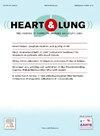Time to death after compassionate extubation in medical and neuroscience intensive care units
IF 2.4
4区 医学
Q2 CARDIAC & CARDIOVASCULAR SYSTEMS
引用次数: 0
Abstract
Background
Medical ICU (MICU) and neuroscience ICU (NSICU) populations undergoing compassionate extubation (CE) may have different characteristics that affect post-procedure outcomes.
Objectives
To contrast clinical characteristics and evaluate time to death (TTD) following CE in MICU and NSICU populations.
Methods
Single-center retrospective cohort study of patients who completed CE in a MICU or NSICU in 2021. Data were obtained by manual chart abstraction. A Mann-Whitney U test was used to compare characteristics between the clinical units.
Results
Fifty patients were included in the study, 27 were in the MICU and 23 in the NSICU. Median age was 68 years. Patients in the MICU had a longer LOS before CE than those in the NSICU (10.0 vs. 3.0 days, p=0.001). Patients in the MICU experienced a shorter median TTD after CE than those in the NSICU (25 vs. 195 mins, p=0.004). MICU patients had a higher pre-hospital burden of illness (median CCI 6 vs 3, p=0.003), and a higher degree of organ failure at CE (median SOFA 12 vs 6, p<0.001), with more severe hypoxemia (PaO2/FiO2 ratio of 149 vs 360, p<0.001). Most MICU patients died of infection or cancer, compared with NSICU patients who had intracranial hemorrhage or ischemic stroke.
Conclusion
Patients in the NSICU underwent CE after shorter time in the ICU and survived longer afterwards than MICU patients. Patients in the MICU have a higher pre-hospital severity of illness and a higher level of organ failure at the time of CE compared with NSICU patients.
在内科和神经科学重症监护病房实施体恤性拔管后的死亡时间
背景医疗重症监护室(MICU)和神经科学重症监护室(NSICU)接受体恤性拔管(CE)的人群可能具有不同的特征,从而影响术后结果。方法对 2021 年在 MICU 或 NSICU 完成 CE 的患者进行单中心回顾性队列研究。数据通过人工抽取病历获得。结果研究共纳入 50 名患者,其中 27 名在 MICU,23 名在 NSICU。中位年龄为 68 岁。MICU患者的CE前住院时间比NSICU患者长(10.0天对3.0天,P=0.001)。MICU患者在CE后的中位TTD比NSICU患者短(25分钟对195分钟,P=0.004)。MICU 患者的院前疾病负担较重(中位数 CCI 为 6 vs 3,p=0.003),CE 时器官衰竭程度较高(中位数 SOFA 为 12 vs 6,p<0.001),低氧血症更为严重(PaO2/FiO2 比率为 149 vs 360,p<0.001)。与颅内出血或缺血性中风的 NSICU 患者相比,大多数 MICU 患者死于感染或癌症。与 NSICU 患者相比,MICU 患者入院前的病情严重程度更高,CE 时的器官衰竭程度更高。
本文章由计算机程序翻译,如有差异,请以英文原文为准。
求助全文
约1分钟内获得全文
求助全文
来源期刊

Heart & Lung
医学-呼吸系统
CiteScore
4.60
自引率
3.60%
发文量
184
审稿时长
35 days
期刊介绍:
Heart & Lung: The Journal of Cardiopulmonary and Acute Care, the official publication of The American Association of Heart Failure Nurses, presents original, peer-reviewed articles on techniques, advances, investigations, and observations related to the care of patients with acute and critical illness and patients with chronic cardiac or pulmonary disorders.
The Journal''s acute care articles focus on the care of hospitalized patients, including those in the critical and acute care settings. Because most patients who are hospitalized in acute and critical care settings have chronic conditions, we are also interested in the chronically critically ill, the care of patients with chronic cardiopulmonary disorders, their rehabilitation, and disease prevention. The Journal''s heart failure articles focus on all aspects of the care of patients with this condition. Manuscripts that are relevant to populations across the human lifespan are welcome.
 求助内容:
求助内容: 应助结果提醒方式:
应助结果提醒方式:


